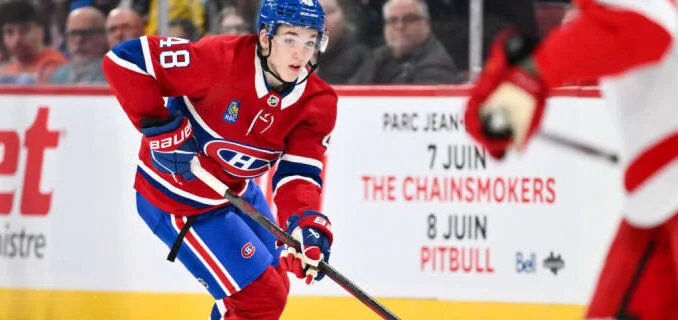“Canadiens Still Have Work to Do Ahead of 2025-26 Season: Roster Questions, Depth Concerns Remain”…see more…

“Canadiens Still Have Work to Do Ahead of 2025-26 Season: Roster Questions, Depth Concerns Remain”…see more…
Montreal, QC – With the 2025-26 NHL season drawing closer, the Montreal Canadiens find themselves at a pivotal crossroads. While there is excitement building around the team’s young core and emerging talent, it is clear the roster still requires significant refinement before the puck drops in October. General Manager Kent Hughes and Head Coach Martin St. Louis have acknowledged progress—but they, too, know the job is far from done.
Building Blocks in Place—but Gaps Still Loom
There’s no denying that the Canadiens have made significant strides since entering their rebuilding phase. The emergence of Cole Caufield, the continued development of Nick Suzuki as team captain, and the growing presence of Juraj Slafkovsky, Kaiden Guhle, and Arber Xhekaj on the blue line have all pointed to a promising future. Add in the goaltending competition between Samuel Montembeault and Cayden Primeau, and the building blocks seem to be in place.
But the NHL is a league of depth and structure, and that’s where Montreal still falls short. While the top six forwards are relatively solidified, questions remain about who can provide consistent secondary scoring. Veterans like Josh Anderson and Christian Dvorak have struggled with consistency and injuries, and their futures in Montreal remain uncertain.
The Canadiens’ third and fourth lines, often the heart of successful playoff-bound teams, are still in flux. Youth will be heavily relied upon—possibly too heavily. Players like Joshua Roy, Owen Beck, and Filip Mesar are on the verge of cracking the lineup, but none are guaranteed to be impact contributors at the NHL level just yet.
Blue Line Balance: A Work in Progress
Montreal’s defense is young, mobile, and full of potential—but it is also error-prone and lacking in veteran leadership. Kaiden Guhle has quickly become the most reliable defenseman, but players like Jordan Harris, Justin Barron, and Jayden Struble still need to refine their two-way games.
The absence of a seasoned, shutdown defender continues to be a thorn in the Canadiens’ side. David Savard provided some veteran presence last season, but at 34, his role is diminishing. Hughes may need to explore a trade or late free-agent signing to bring balance to a defense corps that is otherwise loaded with upside but little structure.
Questions in Goal
Montembeault and Primeau are expected to share the net this season, with Jakob Dobes knocking at the door. While Montembeault showed flashes of brilliance last season, neither he nor Primeau has established himself as a consistent, reliable starter over an 82-game campaign. The Canadiens may once again be rolling the dice in net unless one of them seizes the reins with authority.
The Habs’ refusal to chase a veteran goaltender in free agency may signal confidence in their internal options—but that confidence will need to be validated with results early in the season.
Cap Management and Trade Market Still in Play
Montreal enters the 2025-26 season with some flexibility, thanks in part to a young, inexpensive roster and smart cap management. However, the team also carries contracts that may need to be addressed, including those of Anderson and Dvorak, which could be used as trade chips to acquire needed depth or future assets.
Kent Hughes has been patient during his tenure, prioritizing long-term sustainability over short-term gains. But with fan expectations rising, the pressure to make bold moves will only increase. Whether Hughes makes a splash before training camp or waits until the trade deadline will depend heavily on how confident the organization is in its current mix.
Coaching and Identity
Martin St. Louis has fostered a positive, player-first culture in the locker room, which has resonated particularly well with the younger players. However, translating effort into wins remains the challenge. The Canadiens often play fast and aggressive hockey, but their lack of structure has cost them games late—something St. Louis himself has noted in post-game interviews.
The identity of this Canadiens team remains in flux. Are they a gritty rebuild squad? A team on the cusp of contention? Or something in between? The coming months will go a long way in answering that.
What Needs to Happen Before Opening Night?
1. Establishing Bottom-Six Roles – Montreal must sort out who fills the third and fourth-line roles. Youth can only take them so far, and veterans must prove they still belong.
2. Finding Defensive Stability – Whether through internal development or external addition, the defense needs a glue piece—a player who can calm things down when the game gets chaotic.
3. Goaltending Clarity – Someone—Montembeault, Primeau, or even Dobes—must emerge as the number one goalie and provide consistent starts.
4. Possible Trade Movement – With roster congestion and questions about veteran impact, don’t be surprised if Hughes pulls the trigger on a deal before training camp wraps.
5. Team Identity – The Canadiens must decide what kind of hockey they want to play—and build a lineup that can execute it nightly.
Conclusion
The Canadiens are no longer the basement-dwelling franchise of a few years ago. The light at the end of the tunnel is visible—but it’s not here yet. With young stars, financial flexibility, and a front office committed to the long game, Montreal is in a healthier position than many rebuilding teams.
Still, as the 2025-26 season nears, the clock is ticking. Roster decisions must be made, leadership needs to solidify, and performance on the ice must match the promise on paper. The Canadiens have a foundation—but finishing the house before winter hits remains the task at hand.



